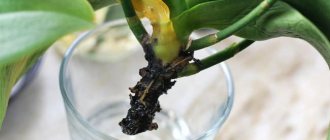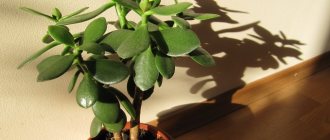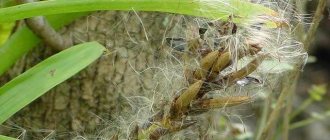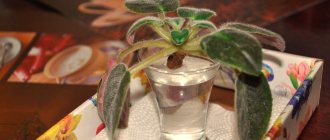Dracaena is becoming an increasingly popular indoor and office plant. She is unpretentious in care, but there are still certain nuances. One of the aspects that you need to pay attention to in order to grow a large, spreading “palm” is regular replanting. How to properly transplant a dracaena into a new pot, and when it is necessary to do this, is discussed in detail in our article.
How to choose soil?
In order for dracaena to feel comfortable in a new place, it needs a well-drained substrate, light, breathable, absorbing a sufficient amount of moisture, with a slight acidity of 6-6.5 pH.
Ready-made earth mixture: pros and cons
The easiest way is to buy a ready-made substrate in a store; choosing soil for dracaena will not be difficult to find. The problem is that most of these soils contain peat. It quickly absorbs water, but hardly releases it, so the soil quickly dries out and the plant does not receive enough moisture.
HELP : As a compromise, you can choose a universal soil for indoor plants. It is suitable for growing dracaena, but still will not be optimal.
How to prepare the soil mixture yourself?
To provide the dracaena with the necessary conditions, it is better to prepare the soil yourself. You can take turf soil as a basis, add leaf soil, humus and coarse sand to it in a ratio of 2:1:1:1.
Is it possible to replant and prune dracaena at the same time?
The issue requires detailed consideration, since most sources categorically do not recommend combining operations. They motivate this by the fact that the plant already receives stress from replanting, and here they also shorten the shoots - the load is too great.
In the spring, the crop tolerates pruning almost painlessly, but quickly awakens new buds, and this is, indeed, an additional burden. If they do not do a full transplant, but a transshipment, the shoot is shortened or not, at the request of the owners.
When completely replacing the substrate, they look at the condition of the roots and the size of the flower. When the underground part is normal, it is better not to touch the trunk, but to water the dracaena after transplantation with a stimulant - Kornevin, heteroauxin.
If you had to clean out rotten areas, shortened sucking shoots can provide nutrition and water supply to a small cutting. But a large dracaena will take on too many plastic substances and will not allow the root system to fully and quickly develop.
The leafy part will have to be cut off. Even if the plant fails, and first of all it does not regenerate the roots, but awakens new buds, the young leaves will quickly dry out. It is better to help them and break them out immediately after swelling.
In summer, dracaena is treated in the same way as in spring. The difference is that before rooting, dormant buds are unlikely to wake up.
Transplanting a crop at the end of the season is always an emergency, associated with serious troubles. Root regeneration is extremely slow; if a flower is forced to expend energy on maintaining the leaf apparatus, this can lead to its death. It is recommended to cut off the above-ground part.
Transplantation process
At home, a young dracaena needs to be replanted every year, a slightly older one - once every 2-3 years as the root system grows. There is nothing complicated about it. Before transplanting, you need to prepare everything you need:
- another pot;
- priming;
- drainage;
- scissors or pruning shears.
ATTENTION! Approximately 3 days before transplanting, watering must be stopped. This will make it easier to remove the flower from the old pot.
Magic properties
The flower has become especially popular in China; in this country it is called “bamboo happiness.” The energy of dracaena ensures the financial well-being of the residents of the house and attracts positive energy, helps in love and friendships and gives people long life.
Dracaena has a calm character. Lush foliage on a bare shoot symbolizes organization and orderliness. The flower helps clear thoughts of negativity. It is worth noting the positive effect of the plant on human health - the leaves of Dracaena Marginata help wounds heal faster and resist skin diseases. The energy of the plant has a beneficial effect on the musculoskeletal system, as well as on the condition of the teeth.
According to Feng Shui, dracaena should be placed near the front door, in this way the owners of the house express their respect for the guests and wish them all the best. Dracaena is considered an ideal gift for loved ones. The number of shoots is also symbolic:
- three - attracts happiness;
- five - gives financial security;
- seven - improves health;
- twenty-one - ensures success in all matters.
There are compositions consisting of 20 twisted stems. They are called the "Tower of Love".
How to choose a pot?
For a dracaena 40–50 cm high, you will need a pot with a diameter of about 20 cm; for each subsequent transplant, you need to choose a container 2–3 cm wider than the previous one. The material and shape of the pot do not play a big role, but clay or ceramic containers, the height of which is slightly greater than the diameter, are considered the most comfortable.
You should not choose a pot that is significantly larger in size than the previous one. The root system of the plant will not be able to immediately absorb too much volume, and this will lead to stagnation of moisture and acidification of the soil.
Soil composition and pot selection
High-quality soil or nutrient substrate for growing palm trees can be represented by different compositions. As a rule, in indoor growing, gardeners use self-prepared soil mixtures. The peat-containing substrate must have an acidity level of 6.0-6.5. The most suitable option for growing dracaena is a nutrient mixture based on leaf, compost and peat soil, as well as turf soil, mixed in a ratio of 1:1:0.5:2.
To prevent soil caking, it is advisable to add a small amount of river sand to the mixture. Ready-made soil mixtures must contain the optimal combination of nutrients and microelements necessary for the growth and development of indoor crops.
The dimensions of the flower pot should correspond as much as possible to the growth characteristics of the indoor dracaena. If the stem part of the plant has grown to 40-45 cm, then it is recommended to give preference to glass-shaped flower pots, the diameter of which is approximately 20 cm. When choosing a flower pot, it is important to remember that with each subsequent transplant, the diameter of the container should be several centimeters larger , and from the walls to The roots of the earthen coma remained about a couple of centimeters. Many experienced amateur flower growers are convinced that ceramic flowerpots are best suited for dracaena. The current opinion is justified by the best supply of oxygen to the root system due to the porosity of the structure of the planting container. However, floriculture practice shows that plastic flower pots do not reduce the growth processes of dracaena and the plant develops quite harmoniously in such a container.
In what cases is a transplant required?
Determining when dracaena needs to be transplanted into a new pot is quite simple. This needs to be done if:
- the time has come for a planned transplant;
- the plant has outgrown the previous pot and roots are visible on its surface and in the drainage holes;
- the soil is chosen incorrectly and is not suitable for dracaena;
- there is a suspicion that the soil is infected with pests, fungus or mold;
- the soil became waterlogged and the roots rotted;
- Excessive fertilization led to plant disease.
ATTENTION! It is better to replant dracaena in early spring. This period is the most favorable, since the plant enters the stage of active growth and most easily adapts to changes.
Step-by-step instructions for transplantation
The sequence of actions is quite simple, if you follow it, there should be no problems.
- Prepare everything you need. Wash the pot and tools with soap and scald with boiling water.
- Carefully remove the dracaena from the old pot and carefully examine the roots. All damaged areas of the roots must be trimmed using pruning shears, and the cut areas must be treated with crushed activated carbon or iodine.
- Place 2–3 cm of drainage at the bottom of the pot, and then add a small layer of soil.
- Place the plant in the center and gently sprinkle with soil so that it fills all the voids between the roots.
- Water thoroughly.
To help dracaena restore damaged roots, you can use one of the plant growth stimulating agents, such as Kornevin or Zircon.
How to know if your dracaena needs a transplant
One of the following signs serves as a signal for a planned transplant:
- an earthen ball entwined with roots;
- lower shoots that appear above the ground surface or break through drainage holes;
- deformed pot;
- the root filled the container, displaced almost all the soil, and during irrigation there was nowhere to pour water.
Sometimes an emergency (urgent) transplant of dracaena is required, regardless of the season:
- soured substrate;
- the root rots;
- soil pests appeared;
- Initially, the wrong soil was used, the transplanted plant looks depressed and is constantly sick;
- from watering with salt water, the surface of the earthen clod and the walls of the container are covered with a white coating, which does not allow moisture and air to pass through;
- forgot to put in drainage.
Do I need to replant immediately after purchase?
A flower bought in a store always needs to be replanted, but there is no need to rush into it. If the plant feels good, does not turn yellow and does not show signs of disease, it is better to wait until spring.
In any case, it is necessary to give the dracaena at least 2-3 weeks to adapt to the new conditions, and only after that proceed with replanting, otherwise the plant, weakened by the move, may not tolerate additional stress.
Care after transplant
The rules remain the same, but for a weakened plant it is especially important to maintain temperature and humidity, as well as adherence to the watering regime. It is important to avoid direct sunlight, drafts, as well as excess moisture or drying out of the soil.
Possible problems
If the transplant is unsuccessful, there is a risk of problems. Dracaena may begin to lose its decorative effect. In this case, the foliage will look drooping and yellowed. The reasons for the plant's malaise lie in mistakes made during its replanting and subsequent care. Among them you can see:
- Illiterate selection of soil mixture. The ornamental crop does not do well in heavy and oily soil with a high peat content.
- Using a container larger than required. There is a risk of soil acidification and the development of putrefactive flora.
- Excessive watering of a plant that has undergone transplantation. After replanting, the false palm tree should be watered as the top layer of soil dries. Water should not stand in the pan. If the plant has suffered from excessive watering, it is necessary to dry the earthen ball, having first removed it from the container.
- Non-compliance with the temperature regime in the room. The transplanted dracaena should not be kept in the cold. It needs warm and humid air.
Yellowing and dying leaves
After transplantation, slight yellowing and loss of foliage may be observed within 14 days.
This is normal. If after two weeks the problem worsens, urgent action is required. What happens is provoked by excessive soil moisture or increased fat content and air impermeability. It will be necessary to reduce watering, and in case of urgent need, change the soil to a suitable one.
Dry and darkened tips of leaves are a sign of excessive dry air in the room. The solution to the problem is spraying.
Attention. When kept in cold conditions, the leaves of the false palm may begin to turn black. This complication is also caused by the contact of the green decoration of the plant with cold glass.
The plant has dropped its leaves
Drooping leaves are normal after transplanting dracaena. The plant has experienced stress and needs to be restored. A warm shower will help the false palm return to normal. During the water procedure, waterlogging of the soil should be avoided. It is advisable to cover the soil in the pot with plastic wrap.
Correctly carried out transplantation will help the dracaena to remain healthy and maintain its decorative appearance. It is enough to follow the technique of performing the procedure and properly care for the plant after manipulation.
Cuttings
Beautiful palm trees do not reproduce easily and only by seeds. And dracaena, which is so similar to a palm tree, can be easily grown from cuttings. Both the tops and sections of the stem can be rooted. Thus, you can not only get a new plant, but also rejuvenate the old one.
Unlike capricious palm trees, dracaenas are easy to take cuttings
Planting cuttings
- In an adult and healthy dracaena, use a sharp sterile knife to cut off the stalk by 3–5 cm: the top of the stem with leaves.
In a month or two, the detached cutting will become an independent plant
- Fill a small pot with coarse sand or vermiculite, into which you slightly bury the cutting.
- Make a kind of greenhouse, cover the cutting along with the pot with a bag.
- Keep warm (temperature should not be lower than +25 ° C) and in partial shade.
- Spray and ventilate the seedling, water through the pan.
- It takes a month or two for rooting.
Don’t ignore a plant without a crown either. Sprinkle the wound with coal and dry it. Spray the plant with growth stimulants. After 3–4 weeks, new buds will begin to develop under the cut. Dracaena will get a second life.
New shoots appeared on the mother dracaena under the cut
The amazing vitality of dracaena and its ability to reproduce formed the basis of the Aztec legend. According to it, the high priest, who did not want to give his daughter in marriage to a warrior, stuck a stick in the ground and said that if leaves did not appear on it in five days, there would be no wedding. And he promised to execute the groom. The warrior began to water this stick. And on the fifth day leaves grew on it - and thus the dracaena was born. The Aztecs call it the tree of happiness.
Dracaena is also propagated by cuttings of stems up to 12 cm. The sections are dusted with coal, the cuttings are dropped in moistened sand and a greenhouse is set up. Just don't confuse the top end with the bottom. Such cuttings take root in 2–3 weeks.
Some gardeners create original compositions by planting several young dracaenas in one pot. This makes them look more magnificent. However, you should not plant old and young dracaenas together. An adult plant will not allow a teenager to develop.
Rooting dracaena cuttings
Pests, diseases and methods of controlling them
Fungal diseases
To combat this kind of disease, you need to treat the plant with Actellik. Treatment is carried out three times with a break of seven days. During treatment, the flower is quarantined.
You also need to replace the soil with new one; before planting, it is disinfected in the freezer or oven.
Viral or bacterial diseases
To treat Dracaena, use fungicides - for example, Alirin, Fitosporin or Carbendazim. The method of application for each drug is described in the instructions.
Aphid
The leaves curl and fall off. To destroy the pest, the flower is treated with Fitoverm.
Shchitovka
The stem and leaf blades become covered with a gray coating, the crown falls off. To begin with, insects are removed mechanically using a cotton swab dipped in soapy water. And then they treat the flower with Actellik.
Mealybug
A white coating appears on the leaves. To combat it, the crown of the plant is treated with an alcohol solution and then with Neoron.
Thrips
Characterized by the appearance of white dots on the upper side of the leaves. To destroy, spray with Fitoverm.
Spider mite
A cobweb appears on the entire surface of the flower. To prevent occurrence, monitor the air humidity in the room - it should be high. And for the fight they use the drug Akarin.
Reproduction of dracaena fringe
Apical cuttings
This is the easiest way to reproduce. To achieve this, the following activities are carried out:
- At the end of spring, the upper shoots are cut off.
- Sprinkle the cut areas with crushed coal, and dry the shoots for 2–3 hours.
- Treat the base with a growth stimulator.
- Plant the cuttings in moist soil with a high sand content.
- Cover the cutting with polyethylene.
- Open the greenhouse every day and moisten the soil there.
- As soon as the first roots appear, the plant is transplanted into a permanent pot.
Water the cuttings two weeks after planting.
Air layering
To do this, cut the plant trunk a little and remove the bark from the cuts. Cover the cut area with moss or polyethylene. As soon as a shoot with roots appears at the cut site, trim it and transplant it into a separate container.
Stem cuttings
This option is more suitable for tall plants with bare trunks. Cut the long trunk into equal parts 7–10 cm long, treat the tops with paraffin and the bottom with a root growth stimulator.
Place the cuttings in water, and after roots appear, transplant them into a flowerpot.
Seeds
Soak the seeds for a day in a growth stimulator. At the same time, they need to be kept at a high temperature - +30–33 degrees.
After this, plant the seeds in nutritious soil, placing them in a warm place, and water regularly.
Rooting in water
The shoot is obtained in the same way as when obtaining apical cuttings. The resulting shoots are placed in warm water in a well-lit place until roots appear.
Rooting in soil, sand and hydrogel
These components are placed in a small container. In this case, the substrates must be constantly moistened. Place the container with cuttings in a bright place.











